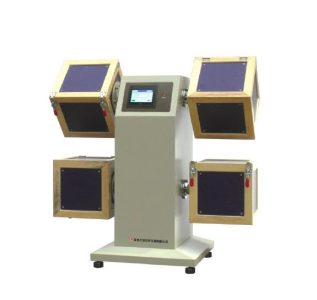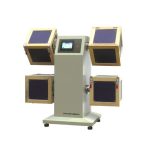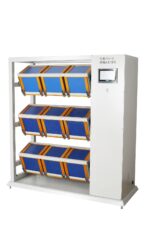ICI Pilling & Snagging Test Machine
An ICI Pilling & Snagging Test Machine is a specialized laboratory instrument designed to evaluate the resistance of textile fabrics to pilling and snagging, which are common surface defects caused by wear and friction. This tester is widely used in quality control and research and development within the textile industry to ensure fabric durability and appearance retention.
The ICI Pilling & Snagging Test Machine simulates the mechanical action that fabrics undergo during actual wear. Test specimens are mounted on polyurethane tubes and placed inside cork-lined boxes. These boxes rotate at a specified speed, causing the specimens to tumble and rub against the cork lining and themselves, thereby replicating the conditions that lead to pilling and snagging
Digital Control Panel: Equipped with a user-friendly interface, often featuring a touchscreen display for setting test parameters and monitoring progress.
– Detachable Cork Liners: Cork liners inside the boxes are removable, facilitating easy replacement and maintenance. – Compliance with International Standards: Designed to meet various testing standards, including ISO 12945-1, BS 5811, JIS L1076, and IWS TM152, ensuring reliable and comparable results.
✅ Benefits of ICI Pilling & Snagging Test Machine:
– Accurate Simulation of Wear Conditions: Replicates the mechanical stresses that fabrics experience during actual use, providing realistic assessments of pilling and snagging tendencies.
– Enhanced Quality Control: Enables manufacturers to identify and address potential issues in fabric durability before products reach the market.
– Versatility: Suitable for testing a wide range of fabrics, including woven and knitted materials, under various conditions.
– Efficient Testing Process: Multiple specimens can be tested simultaneously, increasing throughput and productivity in laboratory settings.
Typical Applications
– Textile Manufacturing: Assessing the durability of fabrics during the development of new materials or quality assurance of existing products. Research and Development: Studying the effects of different yarns, weaves, and finishes on fabric performance. – Quality Assurance: Ensuring that fabrics meet specified standards for pilling and snagging resistance before mass production.
In summary, the ICI Pilling & Snagging Tester is an essential tool in the textile industry for evaluating the surface durability of fabrics. Its ability to simulate real-life wear conditions and provide standardized assessments helps manufacturers and researchers ensure the quality and longevity of textile products.
Features of ICI Pilling & Snagging Test Machine:
- Multiple Test Stations – Typically available in 2, 4, 6 & more -box configurations for simultaneous testing of multiple samples.
- Rotating Pilling Boxes – Cork-lined boxes rotate at a fixed speed (usually 60 ± 2 rpm) to simulate wear and friction.
- Adjustable Timer – Digital timer allows precise control over test duration (usually up to 9999 cycles).
- Detachable Cork Liners – Easily replaceable liners to maintain consistent friction surfaces and accurate results.
- Standard Tubes & Sample Holders- Polyurethane or foam-covered tubes hold fabric samples in a consistent shape during testing.
- Digital Display or Touch Panel – User-friendly interface for setting speed, cycle count, and monitoring progress.
- Compact and Sturdy Design – Built to withstand long testing cycles and minimize vibration.
- Compliance with International Standards – Supports ISO 12945-1, BS 5811, JIS L1076, IWS TM152, etc.
- Low Noise Operation – Engineered for quiet performance in lab environments.
- Safety Features – Includes secure locking system on doors and overload protection.
How to Use ICI Pilling & Snagging Test Machine:
- Prepare Samples – Cut fabric specimens to standard size (typically 125 mm × 125 mm).
– Mount each sample around a polyurethane tube and secure it with elastic bands or ties.
- Load into Pilling Boxes – Place each prepared tube into the cork-lined rotating boxes of the machine.
- Set Test Parameters – Use the digital control panel to set the number of revolutions (e.g., 7200 for ISO 12945-1) and speed (usually 60 ± 2 rpm).
- Start the Test- Close the box lids securely and press “Start.” The boxes will rotate, tumbling the samples inside.
- Monitor Progress – The timer counts down the set cycles. No need for manual supervision during the run.
- End of Test – Machine stops automatically when the cycle count is reached. Open the boxes and remove the tubes.
- Evaluate Results – Remove the fabric from the tubes and visually assess pilling or snagging using standard photographic rating scales (e.g., ASTM D3512, ISO 12945)
- Clean the Machine – Remove lint and debris from cork liners and clean tubes if needed.
Tip: Always ensure samples are mounted uniformly to avoid inconsistent results.
Use ICI Pilling & Snagging Test Machine
Rolling Pilling Tester
series rolling Pilling Resistance tester
type rolling Pilling Resistance instrument
[Scope of application] It is used for testing the pilling degree of fabrics (especially wool knitted fabrics) under no pressure.
[Related standards]:GB/T4802.3 ISO12945.1 JIS L1076 IWS TM152 BS5811 etc.
[Instrument characteristics]
1. color touch screen menu operation in Chinese.
2. AC servo motor quiet driving, adjustable speed.
3. Inner village rubber cork adopts detachable design.
4. Contactless photoelectric counting, liquid crystal display.
Technical parameters of ICI Pilling & Snagging Test Machine:
Model: Number of pilling boxes
2 4 6 9
Inter Size: 225×225×225mm
Rotating speed of box: 60±2r/min
Counting range: The 1~99999 time
[Sample carrying tube]:
1: The shape is 31.5 x 140 mm weight 52.25g.
2: 4 root / box
Power Supply: Ac 220V±10% 50Hz 120W
Outline size (mm): 930×500×580, 930×500×950, 930×500×1410, 1260×560×1470
Weight (Kg): 60 65 125 165



 Products
Products
 Martindale abrasion tester Updated
Martindale abrasion tester Updated

















 It is used to change the color fastness of the textile,
printing and dyeing, printing and other products after a specific track friction.
[Related standards]
GB / T29865 AATCC116 ISO105-X16, etc.
[Instrument characteristics]:
1.Single-chip control, speed can be set freely
2.Imported motor, linear guide, low noise, suitable for long time work
3. Liquid crystal display, film panel
4. Freely set the number of friction, can count up and down,
and automatically stop the alarm when the set value is reached
[Technical Parameters]:
1. Friction head diameter: 16mm 25mm
2. Vertical pressure: 11.1N
3. Working mode: 405 ° clockwise and 405 ° counterclockwise
4. Speed range: constant 60 rpm, LCD display, thin mold panel
5. Counting range: 0-99999 times
6. Power supply: AC 220V 50Hz 80W
7. Weight: 20KG
8. Volume: L420mm × W260mm × H430mm
It is used to change the color fastness of the textile,
printing and dyeing, printing and other products after a specific track friction.
[Related standards]
GB / T29865 AATCC116 ISO105-X16, etc.
[Instrument characteristics]:
1.Single-chip control, speed can be set freely
2.Imported motor, linear guide, low noise, suitable for long time work
3. Liquid crystal display, film panel
4. Freely set the number of friction, can count up and down,
and automatically stop the alarm when the set value is reached
[Technical Parameters]:
1. Friction head diameter: 16mm 25mm
2. Vertical pressure: 11.1N
3. Working mode: 405 ° clockwise and 405 ° counterclockwise
4. Speed range: constant 60 rpm, LCD display, thin mold panel
5. Counting range: 0-99999 times
6. Power supply: AC 220V 50Hz 80W
7. Weight: 20KG
8. Volume: L420mm × W260mm × H430mm 




 Scope of application
It is used to determine the moisture permeability of various fabrics
(including moisture permeable coated fabrics)
and nonwovens such as batting cotton and space cotton.
[Related standards] GB/T12704 ASTM E90 JIS L1099A BS 7209 JIS L1099B (custom) etc.
Instrument characteristics
1. Integrated structure of baking oven and constant temperature and humidity box.
2. Microcomputer control, color touch screen Chinese menu operation.
3. Circulating air velocity 0.2-3m/s digital setting.
4. Imported high-precision temperature and humidity sensor, imported motor drive, ceramic
heating tube heating.
Technical parameters
1.Work mode: Microcomputer control, color touch screen Chinese menu operation, test environment monitoring.
2. Sample box control temperature:15 ~ 40 C, accuracy 0.1 + C, resolution 0.01 C
3. Heat dissipation mode:Air cooling
4. Sample box control humidity:30 ~ 95%, precision + 2%, resolution 0.01%
5. Test chamber humidification:≥300ml/h
6. Accompany oven control temperature: Room temperature to 200 c
7. Test time:1min~999h59min
8. The rate of circulating steam flow:0. 2-3m/s digital setting resolution 0.01m/s
9. Moisture permeability area:2827㎜2(∮60㎜GB)
Optional 3848, 2 (70 70 ASTM)
10. The number of moisture permeable cups.6 (GB) can be replaced by 6 (US standard).
11. Internal dimensions of drying oven:490×400×215mm
12. Power supply:Ac220V 50Hz 6kw
13. Size:930×820×1700mm
14. Weight:350kg
Scope of application
It is used to determine the moisture permeability of various fabrics
(including moisture permeable coated fabrics)
and nonwovens such as batting cotton and space cotton.
[Related standards] GB/T12704 ASTM E90 JIS L1099A BS 7209 JIS L1099B (custom) etc.
Instrument characteristics
1. Integrated structure of baking oven and constant temperature and humidity box.
2. Microcomputer control, color touch screen Chinese menu operation.
3. Circulating air velocity 0.2-3m/s digital setting.
4. Imported high-precision temperature and humidity sensor, imported motor drive, ceramic
heating tube heating.
Technical parameters
1.Work mode: Microcomputer control, color touch screen Chinese menu operation, test environment monitoring.
2. Sample box control temperature:15 ~ 40 C, accuracy 0.1 + C, resolution 0.01 C
3. Heat dissipation mode:Air cooling
4. Sample box control humidity:30 ~ 95%, precision + 2%, resolution 0.01%
5. Test chamber humidification:≥300ml/h
6. Accompany oven control temperature: Room temperature to 200 c
7. Test time:1min~999h59min
8. The rate of circulating steam flow:0. 2-3m/s digital setting resolution 0.01m/s
9. Moisture permeability area:2827㎜2(∮60㎜GB)
Optional 3848, 2 (70 70 ASTM)
10. The number of moisture permeable cups.6 (GB) can be replaced by 6 (US standard).
11. Internal dimensions of drying oven:490×400×215mm
12. Power supply:Ac220V 50Hz 6kw
13. Size:930×820×1700mm
14. Weight:350kg 


 burning of flammable textile materials after ignition.
(specific ignition nozzles and sample holders can be customized to meet multiple criteria).
Related standards
GB/T14644 ASTM D1230 CFR1610 etc.
Technical parameters
1. The spread of time:0 ~ 999.9S resolution 0.1S
2. The temperature inside the box shows:Room temperature -99 degrees C resolution 1 c
3. Igniting time:1S
4. Type of igniter:4 1/2 syringe
5. Sample clip size:Outer frame:204mm * 78mm inner frame:152mm×38mm
6. Distance from the top of the igniter to the sample surface:8mm
7. Studio size and outline size
Studio size:370mm×220mm×350mm
Outline size:375mm×245mm×478mm
8. Power supply:AC220V 50Hz 20W
9. Weight:18Kg
burning of flammable textile materials after ignition.
(specific ignition nozzles and sample holders can be customized to meet multiple criteria).
Related standards
GB/T14644 ASTM D1230 CFR1610 etc.
Technical parameters
1. The spread of time:0 ~ 999.9S resolution 0.1S
2. The temperature inside the box shows:Room temperature -99 degrees C resolution 1 c
3. Igniting time:1S
4. Type of igniter:4 1/2 syringe
5. Sample clip size:Outer frame:204mm * 78mm inner frame:152mm×38mm
6. Distance from the top of the igniter to the sample surface:8mm
7. Studio size and outline size
Studio size:370mm×220mm×350mm
Outline size:375mm×245mm×478mm
8. Power supply:AC220V 50Hz 20W
9. Weight:18Kg


 It is used for testing dynamic and static drape properties
(drape coefficient, shape change rate, surface ripple and drape uniformity, etc.)
of various fabrics.
Related standards GB/T23329 FZ/01045 BS5058 etc.
Instrument characteristics
1. CCD imaging, dynamic and static image processing.
2. A variety of charts and data statistics, analysis, storage, output
3. No need to replace background color, can test all kinds of color samples.
4. Work mode:Microcomputer control, CCD imaging, automatic processing of images and data automatically.
Technical parameters
1. Communication interface: RS232, USB
2. Image sensor: CCD sensor.
3. Static (dynamic) state draping coefficient: 0 ~ 100% + 2
4. Drapability uniformity: 0 ~ 100% + 2
5. The rate of morphological change is 0 to 100% + 2.
6. Surface waviness error: + 1
It is used for testing dynamic and static drape properties
(drape coefficient, shape change rate, surface ripple and drape uniformity, etc.)
of various fabrics.
Related standards GB/T23329 FZ/01045 BS5058 etc.
Instrument characteristics
1. CCD imaging, dynamic and static image processing.
2. A variety of charts and data statistics, analysis, storage, output
3. No need to replace background color, can test all kinds of color samples.
4. Work mode:Microcomputer control, CCD imaging, automatic processing of images and data automatically.
Technical parameters
1. Communication interface: RS232, USB
2. Image sensor: CCD sensor.
3. Static (dynamic) state draping coefficient: 0 ~ 100% + 2
4. Drapability uniformity: 0 ~ 100% + 2
5. The rate of morphological change is 0 to 100% + 2.
6. Surface waviness error: + 1